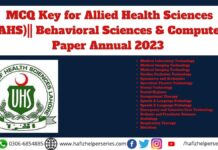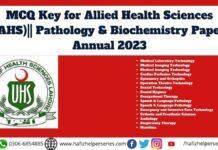CHAPTER No. 02
1. What is the effect of NSAIDs (e.g., Naprosyn, Motrin, Anaprox, ibuprofen) on blood pressure?
a. No effect
b. Increases blood pressure
c. Decreases blood pressure
2. Most of the information needed to determine the cause of symptoms is contained in the:
a. Subjective examination
b. Family/Personal History Form
c. Objective information
d. All of the above
e. a and c
3. With what fnal question should you always end your interview?
Any of the following questions (or similar questions) is appropriate:
- Are any other symptoms of any kind anywhere else in your body that we haven’t discussed yet?
- Is there anything else you think is important about your condition that we have not discussed yet?
- Is there anything else you think I should know?
4. A risk factor for NSAID-related gastropathy is the use of:
a. Antibiotics
b. Antidepressants
c. Antihypertensives
d. Antihistamines
5. After interviewing a new client, you summarize what she has told you by saying, “You told me you are here because of right
neck and shoulder pain that began 5 years ago as a result of a car accident. You also have a ‘pins and needles’ sensation in your
third and fourth fngers but no other symptoms at this time. You have noticed a considerable decrease in your grip strength,
and you would like to be able to pick up a pot of coffee without fear of spilling it.” This is an example of:
a. An open-ended question
b. A funnel technique
c. A paraphrasing technique
d. None of the above
6. Screening for alcohol use would be appropriate when the client reports a history of accidents.
a. True
b. False
7. What is the signifcance of sweats?
a. A sign of systemic disease
b. Side effect of chemotherapy or other medications
c. Poor ventilation while sleeping
d. All of the above
e. None of the above
8. Spontaneous uterine bleeding after 12 consecutive months without menstrual bleeding requires medical referral.
a. True
b. False
9. Which of the following are red flags to consider when screening for systemic or viscerogenic causes of neuromuscular and musculoskeletal signs and symptoms:
a. Fever, (night) sweats, dizziness
b. Symptoms are out of proportion to the injury
c. Insidious onset
d. No position is comfortable
e. All of the above
10. A 52-year-old man with low back pain and sciatica on the left side has been referred to you by his family physician. He has
had a discectomy and laminectomy on two separate occasions about 5 to 7 years ago. No imaging studies have been performed (e.g., x-ray examination or MRI) since that time. What follow-up questions should you ask to screen for medical disease?
The first question should always be, “Did you actually see your physician?” Then ask questions directed at assessing for the presence of constitutional symptoms. For example, after paraphrasing what the client has told you, ask, “Are you having any other symptoms of any kind in your body that you haven’t mentioned?” If no, ask more specifically about the presence of associated signs and symptoms, including naming constitutional symptoms one by one. Follow up with Special Questions for Men (see Appendix B-21).
11. You should assess clients who are receiving NSAIDs for which physiologic effect associated with increased risk of hypertension?
a. Decreased heart rate
b. Increased diuresis
c. Slowed peristalsis
d. Water retention
12. Instruct clients with a history of hypertension and arthritis to:
a. Limit physical activity and exercise
b. Avoid over-the-counter medications
c. Inform their primary care provider of both conditions
d. Drink plenty of fluids to avoid edema
13. Alcohol screening tools should be:
a. Used with every client sometime during the episode of care
b. Brief, easy to administer, and nonthreatening
c. Deferred when the client has been drinking or has the smell of alcohol on the breath
d. Conducted with one other family member present as a witness
ANSWER KEY
| 01 | B | 02 | A | 04 | B | 05 | C |
| 06 | A | 07 | D | 08 | True | 09 | E |
| 11 | D | 12 | C | 13 | B |










